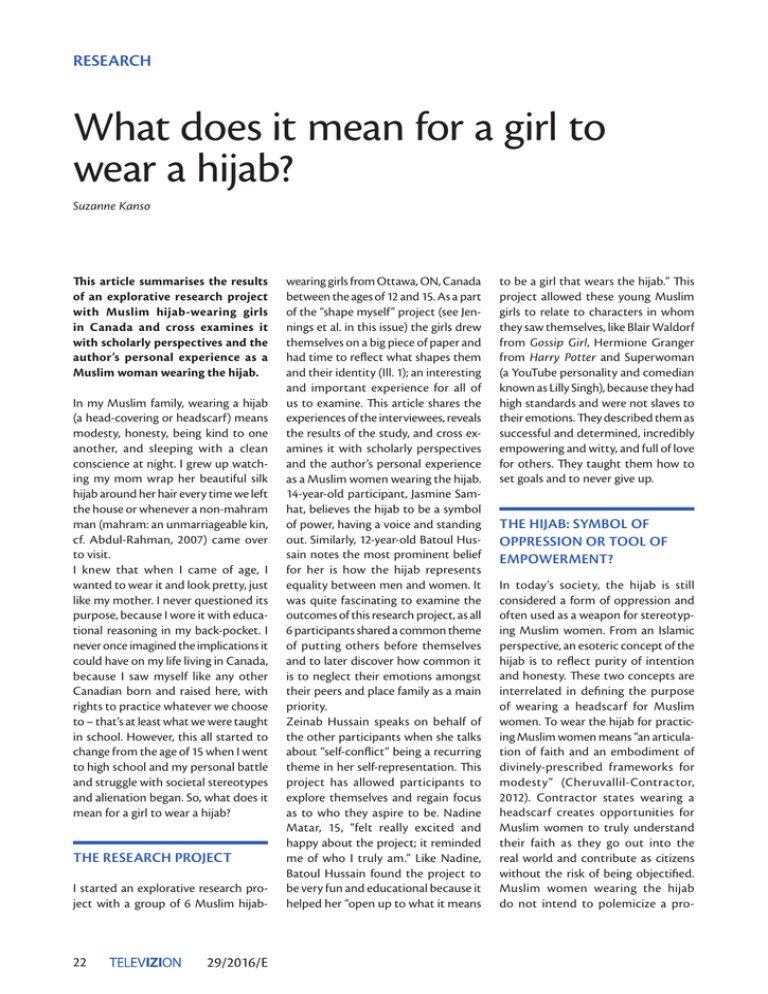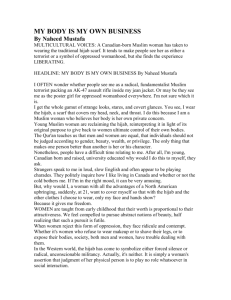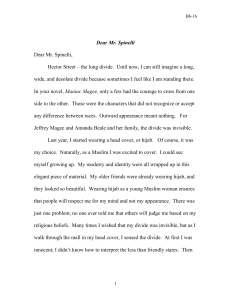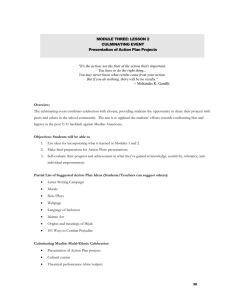
RESEARCH
What does it mean for a girl to
wear a hijab?
Suzanne Kanso
This article summarises the results
of an explorative research project
with Muslim hijab-wearing girls
in Canada and cross examines it
with scholarly perspectives and the
author’s personal experience as a
Muslim woman wearing the hijab.
In my Muslim family, wearing a hijab
(a head-covering or headscarf) means
modesty, honesty, being kind to one
another, and sleeping with a clean
conscience at night. I grew up watching my mom wrap her beautiful silk
hijab around her hair every time we left
the house or whenever a non-mahram
man (mahram: an unmarriageable kin,
cf. Abdul-Rahman, 2007) came over
to visit.
I knew that when I came of age, I
wanted to wear it and look pretty, just
like my mother. I never questioned its
purpose, because I wore it with educational reasoning in my back-pocket. I
never once imagined the implications it
could have on my life living in Canada,
because I saw myself like any other
Canadian born and raised here, with
rights to practice whatever we choose
to – that’s at least what we were taught
in school. However, this all started to
change from the age of 15 when I went
to high school and my personal battle
and struggle with societal stereotypes
and alienation began. So, what does it
mean for a girl to wear a hijab?
THE RESEARCH PROJECT
I started an explorative research project with a group of 6 Muslim hijab-
22
29/2016/E
wearing girls from Ottawa, ON, Canada
between the ages of 12 and 15. As a part
of the “shape myself” project (see Jennings et al. in this issue) the girls drew
themselves on a big piece of paper and
had time to reflect what shapes them
and their identity (Ill. 1); an interesting
and important experience for all of
us to examine. This article shares the
experiences of the interviewees, reveals
the results of the study, and cross examines it with scholarly perspectives
and the author’s personal experience
as a Muslim women wearing the hijab.
14-year-old participant, Jasmine Samhat, believes the hijab to be a symbol
of power, having a voice and standing
out. Similarly, 12-year-old Batoul Hussain notes the most prominent belief
for her is how the hijab represents
equality between men and women. It
was quite fascinating to examine the
outcomes of this research project, as all
6 participants shared a common theme
of putting others before themselves
and to later discover how common it
is to neglect their emotions amongst
their peers and place family as a main
priority.
Zeinab Hussain speaks on behalf of
the other participants when she talks
about “self-conflict” being a recurring
theme in her self-representation. This
project has allowed participants to
explore themselves and regain focus
as to who they aspire to be. Nadine
Matar, 15, “felt really excited and
happy about the project; it reminded
me of who I truly am.” Like Nadine,
Batoul Hussain found the project to
be very fun and educational because it
helped her “open up to what it means
to be a girl that wears the hijab.” This
project allowed these young Muslim
girls to relate to characters in whom
they saw themselves, like Blair Waldorf
from Gossip Girl, Hermione Granger
from Harry Potter and Superwoman
(a YouTube personality and comedian
known as Lilly Singh), because they had
high standards and were not slaves to
their emotions. They described them as
successful and determined, incredibly
empowering and witty, and full of love
for others. They taught them how to
set goals and to never give up.
THE HIJAB: SYMBOL OF
OPPRESSION OR TOOL OF
EMPOWERMENT?
In today’s society, the hijab is still
considered a form of oppression and
often used as a weapon for stereotyping Muslim women. From an Islamic
perspective, an esoteric concept of the
hijab is to reflect purity of intention
and honesty. These two concepts are
interrelated in defining the purpose
of wearing a headscarf for Muslim
women. To wear the hijab for practicing Muslim women means “an articulation of faith and an embodiment of
divinely-prescribed frameworks for
modesty” (Cheruvallil-Contractor,
2012). Contractor states wearing a
headscarf creates opportunities for
Muslim women to truly understand
their faith as they go out into the
real world and contribute as citizens
without the risk of being objectified.
Muslim women wearing the hijab
do not intend to polemicize a pro-
RESEARCH
© IZI
who believes her body
is her own private concern” (Bullock, 2002)
and then adds that
“young Muslim women
are reclaiming the hijab,
reinterpreting it in light
of its original purpose to give back to women
ultimate control of
their own bodies”
(ibid.). In a qualitative
study conducted with
a few participants, Hiba
states she is “terrified to
practice [her] faith by
putting on the hijab in
fear of getting rejected
by society.” For Bullock
the hijab is a tool of
empowerment; a tool
that young Muslim
women can use to reassure society that wearing a headscarf is not
a form of oppression
but rather personal
choice, and that should
Ill. 1: Examples of shapes created by hijab-wearing girls. These self-representations show that the hijab is an
be respected as basic
integral part of their complex identities
human rights. When
asked “What does the
hijab mean for Muslim
hijab stance, rather to articulate in the can, for some, be a symbol of Muslim women?” one can assertively note that
broader scheme of things meeting the women’s subordination. The hijab, it surely is not a form of oppression
basic threshold of basic human rights, fairly viewed as an item of oppression and is notably not a symbol of the
which seeks to ensure and guarantee and denouncement of a woman’s female subordination in the Muslim
the right to religious expression and voice, creates a misconstrued item for faith.
freedom from discrimination.
roundtable debates. Appropriately, this On a further note, Carens (2006)
The headscarf unfortunately has been a implication also silences many Muslim states that the construction of female
wide topic of debate for many policy in- women’s voices as it leaves them with identity in respect to a woman’s abilfluencers and governmental personnel no safe space to talk about their rela- ity to dress in ways that are attractive
in impacting the lives of Muslim-hijabis tionship with/to the hijab.
to men, has contributed more to the
(women who wear the headscarf), by Section 2 of The Canadian Charter of subordination of women than the hijab
undermining Muslim women and their Rights and Freedom states “regardless ever did. Thus even if the hijab does
potential for growth in non-Muslim of whether [one is] a Canadian Citizen stand for the subordination of women
majority countries. Highlighting the or an individual... [these] ‘fundamental within Islam, Taylor & Zine (2014) argue
tension between social and personal freedoms’, namely freedom of con- as to “Why Muslim girls should [not] be
identity often times leads to a mis- science, freedom of religion, freedom permitted to wear it if they choose to
construed image and representation. of thought, freedom of belief, freedom do so?”. What it means to wear the hiFor Muslim women, this intermesh of expression, and freedom of asso- jab surpasses the defined stereotypical
subjugates individuals to marginaliza- ciation, are applicable to all.” (Jacob, norm outlined by society. The choice
tion and alienation. The social and 2007). Bullock believes that the “hijab of wearing a hijab or not, regardless
political ties associated with the hijab means that she is a Muslim woman if it has potential for serving multiple
29/2016/E
23
RESEARCH
purposes, should not have an effect
or any bearing on the rights of girls to
wear the hijab and practice their faith.
PERSONAL EXPERIENCES
WITH THE HIJAB
Wearing the hijab was a personal
choice of mine and not one that was
enforced upon me by my parents
as the alienated picture is typically
painted. Freedom of choice is an imperative principle in the household I
was brought up in. I was 13 years old
when I first wore my hijab, and it was
one of the harshest things to endure as
a kid, because of the marginalization
I received from people and society at
large. I was subjugated to spiteful words
and had to fight back with diplomatic
approaches. I had to learn how to be
Canadian and Muslim and balance
the integration of both worlds into
my life. When exposed to demeaning
comments like “towelhead, terrorist,
etc.” or accused of carrying bombs in
my backpack, society by definition ostracized my self-identification. Society
forbade and stripped me away from
enjoying the innocent pleasures and
privileges of being a kid.
When I turned 25, I made the most
difficult decision of life, and that was
to rid away part of my identity in order
to fit societal expectations and pay
passed due bills. My hair was impressively flattering; it instantly landed me
a career and relieved me from reaching a 3-year mark of unemployment.
Today, I wear my hijab in my heart.
Coming from a Lebanese, Turkish,
and Argentinian background gives
me privilege as a Caucasian-looking
woman to be an educator on topics
of “Hijab, Breaking Stereotypes and
Empowerment.” I, therefore, seek to
provide girls who want to wear the
hijab an opportunity to flourish in
their own skin and create a safe space
for them to identify in whichever
shape or form they wish to represent
themselves.
My hijab is my identity, my right,
my voice, my freedom. I am not oppressed because I wear it; I am rather
oppressed when I am forced to take it
off. As a Canadian from birth, we are
taught from our Canadian constitution the freedom of choice, so I question the validation and authenticity
of such a law when in practice, I am
my own person. My hijab does not
represent who I am as a person. “I”
am not a religion, nor am “I” a topic
of discussion for your political agenda
or societal approval. “I” am a human
being, just like you, and I want to live
free by choosing to do whatever “I”
want to do as an individual.
REFERENCES
Abdul-Rahman, Muhammad Saed (2007). Islam: Questions and Answers – Jurisprudence and Islamic Rulings. London: MSA Publication Limited.
Bullock, Katherine (2002). Rethinking Muslim Women
and the Veil: Challenging Historical & Modern Stereotypes. Richmond: The International Institute of Islamic
Thought. Available at http://www.iiituk.com/docs/pdf/
preamble-veiling-v3.pdf [19.04.16].
Carens, Joseph H. (2006). Culture, Citizenship, and
Community: A Contextual Exploration of Justice as
Evenhandedness. New York: Oxford University Press.
Cheruvallil-Contractor, Sariya (2012). Muslim Women in Britain: De-Mystifying the Muslimah. London:
Routledge.
Jacob, Joseph W. (2007). Canadian Charter of Rights
and Freedoms: Democracy for the People and for each
Person. Victoria: Trafford.
Taylor, Lisa K. & Zine, Jasmin (2014). Muslim Women,
Transnational Feminism and the Ethics of Pedagogy:
Contested Imaginaries in Post-9/11 Cultural Practice.
London: Routledge.
THE AUTHOR
Suzanne Kanso, is a Canadian filmmaker, storyteller, and poet in 3 languages.
She has a degree in Communications
and continued her education in Children’s Media post-graduate masters.
IMPRINT
Published by: Internationales Zentralinstitut
für das Jugend- und Bildungsfernsehen (IZI)
at Bayerischer Rundfunk
Editors: Dr. Maya Götz, Dr. Elke Schlote,
Heike vom Orde, Christina Hunsdorfer
Set by: Text+Design Jutta Cram,
Spicherer Straße 26, 86157 Augsburg,
Germany, www.textplusdesign.de
Printed by: Druckerei Joh. Walch GmbH & Co. KG,
Im Gries 6, 86179 Augsburg, Germany
ISSN 1862-7366
Translation of the German contributions by
Textworks Translations
Address of the publisher:
Internationales Zentralinstitut für das Jugendund Bildungsfernsehen (IZI)
Rundfunkplatz 1, 80335 München,
Ger­many
Telephone: +49 (0)89/5900-42991
Fax: +49 (0)89/5900-42379
Internet: http://www.izi.de
E-mail: IZI@br.de
“TelevIZIon” is published by the IZI twice a year in German, once a year in English, and is distributed free of charge. Please send your order to the address of the
publisher. All rights reserved. Reproduction, including excerpts, only with the prior permission of the publisher.
24
29/2016/E





